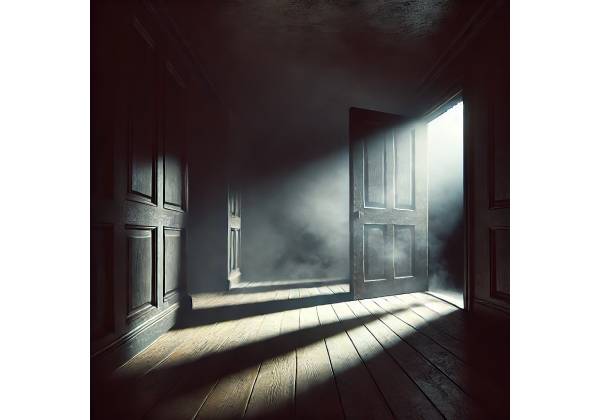
What is Achluophobia?
Achluophobia, also known as the fear of darkness, is a specific phobia that causes intense anxiety when a person is exposed to or anticipates being in a dark setting. While many people feel uncomfortable or uneasy in the dark, those with achluophobia experience overwhelming fear and distress, which can disrupt daily life. For these people, darkness is associated with perceived threats as well as discomfort, which leads to panic or avoidance behavior. This phobia can affect both children and adults, but it is commonly associated with childhood fears.
Achluophobia is more than a fear; it is an anxiety disorder that can severely impair an individual’s ability to function normally. The individual may go to great lengths to avoid dark spaces, such as leaving lights on at night or refusing to enter unlit areas. In more severe cases, the prospect of nightfall can cause anticipatory anxiety, in which the individual becomes consumed with concern about facing darkness. This fear could be caused by a variety of factors, such as previous traumatic experiences, evolutionary survival mechanisms, or pre-existing anxiety disorders.
Living with achluophobia can be difficult, and it can affect many aspects of life, including personal routines and social interactions. However, with the proper support and treatment, fear can be managed and its disruptive effects reduced. Understanding the condition, including its symptoms, causes, and treatment options, is the first step toward obtaining assistance and improving one’s quality of life.
Symptoms of Achluophobia
Achluophobia causes a wide range of physical, emotional, and behavioral symptoms, all of which revolve around an intense fear of darkness. Recognizing the specific symptoms can help you identify the phobia early on and seek appropriate treatment. The following is a detailed look at the most common symptoms of achluophobia.
1. Intense fear of darkness
The primary symptom of achluophobia is a strong and irrational fear of darkness or dark environments. Individuals may experience an immediate sense of dread or panic when exposed to darkness or even just thinking about being in the dark. This fear is frequently disproportionate to the actual threat, as dark places are generally safe but perceived as dangerous by someone with achluophobia.
2. Physical reactions to darkness
When confronted with darkness, people with achluophobia frequently experience intense physical reactions that resemble panic attacks. These physical symptoms may include:
- A rapid heartbeat (tachycardia)
- Hyperventilation or shortness of breath.
- Trembling or shaking.
- Sweating and chills
- nausea or stomach discomfort
- Dizziness/lightheadedness
- Dry Mouth
- Breathing difficulty or chest tightness
These symptoms are caused by the body’s fight-or-flight response to a perceived threat, in this case, a dark environment. The intensity of these symptoms varies according to the severity of the phobia and how much the individual feels trapped or overwhelmed by the darkness.
3. Emotional and psychological distress
Individuals with achluophobia experience increased anxiety, particularly when anticipating being in a dark environment. This anxiety can appear as:
- Panic or fear when faced with darkness
- Constant concern about nightfall or entering dark places.
- Anger or frustration when confronted with the prospect of dealing with the dark
- Feelings of helplessness, as the individual recognizes that their fear is irrational but cannot control their response.
Psychologically, persistent distress can have a significant impact on a person’s mental health, potentially leading to chronic anxiety, depression, or other co-occurring mental health conditions.
4. Behavioral Symptoms
Individuals with achluophobia frequently alter their behavior to avoid darkness or to feel more secure in dark environments. Some common behavioral symptoms are:
- Avoid dark places, such as basements, attics, and even movie theaters.
- Keeping lights on all night to prevent complete darkness
- Use night lights or lamps in areas where they sleep or relax
- Avoiding going out at night or needing a companion to feel safe in the dark
These avoidance behaviors can interfere with daily routines, making it difficult for people to participate in normal activities like going out after sunset or sleeping without a light on. In severe cases, this can lead to social isolation because the fear of darkness disrupts both work and personal life.
5. Sleep Disruption
Achluophobia frequently causes significant sleep disturbances. Individuals might struggle with:
- Insomnia, because the fear of being in the dark makes it difficult to fall asleep.
- Repeated waking at night due to anxiety or fear of the dark.
- Nightmares or night terrors caused by the fear of darkness.
- Difficulty relaxing, even in dimly lit or semi-dark settings.
This sleep disruption can exacerbate the individual’s anxiety and fatigue, resulting in a vicious cycle of stress that harms both their mental and physical well-being.
6. Effect on Relationships and Social Life
Because achluophobia frequently leads to avoidance behaviors, it can disrupt social interactions. Individuals may avoid going out at night, attending evening events, or staying at friends’ houses if they cannot control the lighting. This can cause strain in personal relationships because loved ones may struggle to comprehend the severity of the phobia or become frustrated with the individual’s limitations.
Causes and Risk Factors for Achluophobia
A variety of genetic, psychological, and environmental factors contribute to the development of achluophobia. While the exact cause varies from person to person, there are several known factors that increase the likelihood of developing a fear of darkness.
1. Evolutionary Survival Mechanism
From an evolutionary standpoint, fear of the dark is a natural survival mechanism. Historically, darkness indicated potential danger because predators were more active and visibility was limited. This instinctive apprehension toward darkness is thought to be deeply ingrained in human psychology. Individuals suffering from achluophobia may experience heightened or exaggerated evolutionary responses, resulting in irrational fear even in safe, modern environments.
2. Traumatic Experiences
Achluophobia is often caused by a traumatic experience with darkness. Individuals may have experienced frightening events, such as becoming lost in the dark or witnessing a nighttime accident, that left an indelible impression. Childhood experiences, such as being locked in a dark room, can also elicit this phobia. Even if the event did not take place in complete darkness, low visibility can create a long-term association between darkness and danger.
3. Anxiety and Mood Disorder
Achluophobia is often associated with underlying anxiety disorders. Individuals with generalized anxiety disorder (GAD) or panic disorder are more likely to develop specific phobias, such as achluophobia. Furthermore, those suffering from mood disorders such as depression may experience increased anxiety about darkness during times of emotional distress. The combination of increased anxiety and an irrational fear of darkness can create a vicious cycle that perpetuates the phobia.
4. Genetic Predisposition
There is evidence that people with a family history of anxiety or specific phobias are more likely to develop phobias such as achluophobia. This genetic predisposition can make some people more sensitive to environmental or psychological triggers, allowing them to develop irrational fears more quickly.
5. Cultural and Media Influences
Cultural factors and media exposure can also influence the development of achluophobia. Horror films, folklore, and urban legends that emphasize danger in the dark can all contribute to an increased fear of darkness. Individuals who are already predisposed to anxiety may find that exposure to these types of media exacerbates their fear and deepens the phobia.
How Achluophobia is Diagnosed
Achluophobia is diagnosed after a thorough evaluation by a mental health professional, usually a psychologist or psychiatrist, who assesses the severity and impact of the fear. This process usually consists of the following steps:
1. Clinical Interview
A clinical interview is the initial step in diagnosing achluophobia. The mental health professional will inquire about the patient’s history of symptoms, such as when the fear began, how it manifests, and whether it interferes with their daily life. Questions can also focus on:
- Triggers for the fear (e.g., specific places or times of day)
- Behavioral changes, such as avoiding dark places.
- The existence of physical symptoms such as panic attacks or sleep disturbances.
2. Diagnostic criteria
Achluophobia is classified as a specific phobia according to the **Diagnostic and Statistical Manual of Mental Disorders (DSM-5). To fulfill the diagnostic criteria, the person must:
- Have a persistent and excessive fear of the dark.
- Feel immediate anxiety or panic in response to darkness.
- Actively avoid dark environments or tolerate them with significant distress.
- Have symptoms that interfere with daily functioning and last at least six months.
This framework will be used by the clinician to determine whether the fear is achluophobia or if it is more appropriately classified as generalized anxiety disorder or panic disorder.
3. Differential Diagnosis
The clinician may also perform a differential diagnosis to rule out other conditions that can cause similar symptoms, such as:
- Nyctophobia, which is the fear of the night rather than the actual darkness
- Delusional disorders, in which people believe there is something in the darkness, such as ghosts or intruders.
- Panic disorder, where fear of darkness may trigger broader panic episodes rather than being the only cause.
By distinguishing achluophobia from other conditions, the mental health professional can tailor treatment to the individual’s unique needs.
The Effects of Achluophobia on Daily Life
Achluophobia can have a profound impact on many aspects of daily life, disrupting personal routines, relationships, and mental health. The following are some key areas of life that are frequently impacted by the fear of darkness:
1. Disruption of sleep patterns
Sleep is one of achluophobia’s most immediate and noticeable effects. Individuals with this phobia may have difficulty falling asleep due to an intense fear of darkness, resulting in insomnia or delayed sleep onset. They may also wake up frequently at night, either due to nightmares or fear of the dark. This sleep disruption can cause chronic fatigue, irritability, and difficulty concentrating during the day, all of which can impair overall function.
To cope with their fear, people may leave lights on in their bedrooms, use multiple nightlights, or watch television while sleeping. While these actions may provide temporary relief, they can eventually disrupt healthy sleep hygiene, making restful sleep more difficult to achieve.
2. Social and relationship strain
Achluophobia can cause significant social isolation. To cope with their fear, people may avoid activities that require them to be out after dark, such as dinners, movies, or evening events. This avoidance behavior can strain relationships with friends and family, who may not fully comprehend the severity of the phobia. Loved ones may perceive the individual’s behavior as excessively cautious or irrational, resulting in frustration on both sides.
Achluophobia can cause tension in romantic relationships, especially if partners have varying levels of comfort with darkness or sleeping with lights on. Negotiating bedtime routines or nighttime activities can be difficult, and people with achluophobia may feel embarrassed or ashamed about their need for special accommodations.
3. Impact on Mental Health
Living with achluophobia can have a negative impact on a person’s mental health. Constant anxiety about darkness, as well as measures taken to avoid it, can contribute to chronic stress. Over time, this stress can lead to other mental health conditions, like:
- Generalized anxiety disorder, where the person experiences persistent worry about multiple aspects of life, including their fear of the dark
- Depression, because the individual may feel overwhelmed by their phobia and how it limits their life.
- Panic disorder, especially if being in the dark frequently results in panic attacks.
The emotional burden of living with achluophobia can also lead to feelings of low self-esteem or helplessness, especially if the person is unable to overcome the fear despite knowing it is irrational.
4. Occupational Challenges
Achluophobia can be a significant occupational challenge in some industries. Jobs that require night shifts, travel after dark, or working in dimly lit environments can be extremely stressful. Individuals with severe achluophobia may avoid such jobs entirely or feel limited in their career options due to their fear.
Even in more traditional work settings, achluophobia can impair performance. For example, someone with this phobia may avoid staying late at work if they know they’ll have to drive home in the dark, which could impair their ability to meet deadlines or take on new responsibilities.
5. Daily routines and lifestyle modifications
Individuals with achluophobia frequently change their daily routines to reduce their exposure to darkness. This may include:
- Planning errands and outdoor activities to be completed before sunset.
- Relying on artificial lighting, such as leaving lights on in various parts of the house to avoid entering dark rooms.
- Requesting companions for evening outings to feel safer in dark places.
While these coping mechanisms may temporarily alleviate anxiety, they can limit a person’s autonomy and flexibility. The constant vigilance and planning required for darkness can become exhausting over time, reinforcing the cycle of fear and avoidance.
Treatment Alternatives for Achluophobia
Overcoming achluophobia necessitates a multifaceted approach that addresses both the emotional and physical symptoms of the condition. Individuals who follow the right treatment plan can gradually overcome their fear of darkness and regain control of their lives. The following are some of the most effective treatments for achluophobia.
1. Cognitive behavior therapy (CBT)
Cognitive Behavioral Therapy (CBT) is a highly recommended treatment for specific phobias such as achluophobia. This evidence-based therapy focuses on identifying and altering negative thought patterns and behaviors that contribute to the fear of darkness. Key components of CBT for achluophobia are:
- Cognitive restructuring: This technique assists individuals in overcoming irrational fears of darkness by replacing negative thoughts (e.g., “something bad will happen in the dark”) with more realistic and balanced ones.
- Exposure therapy: Gradual exposure to the feared situation is an essential component of CBT for phobias. In this case, people may begin by spending time in dimly lit rooms, then progress to darker environments as their comfort level grows. This exposure is done in a controlled and safe manner, which helps the individual become desensitized to the fear over time.
- Relaxation techniques: CBT frequently includes relaxation exercises such as deep breathing or mindfulness meditation to help people manage the anxiety that comes with facing darkness.
CBT, especially when combined with exposure therapy, has consistently been shown in studies to significantly reduce achluophobia symptoms and help people regain confidence in managing their fear.
2. Virtual reality exposure therapy (VRET)
Virtual Reality Exposure Therapy (VRET) is a novel and rapidly growing treatment for specific phobias. Individuals wear a virtual reality headset and are immersed in simulated dark environments, allowing them to confront their fears in a controlled and customizable setting. This technology enables gradual and safe exposure to the dark, making it easier for the individual to develop coping strategies and become desensitized to the fear.
Studies have shown that VRET can be extremely effective in reducing the anxiety associated with achluophobia, especially for people who struggle with real-world exposure. The immersive nature of virtual reality can help bridge the gap between therapy and real-life situations, resulting in a more engaging and interactive treatment experience.
3. Medications
In some cases, medications may be prescribed to alleviate the anxiety associated with achluophobia. While medications do not cure phobias, they can alleviate acute symptoms, allowing people to fully participate in therapeutic interventions. Common medications used to treat phobias are:
- Selective Serotonin Reuptake Inhibitors (SSRIs): These antidepressants are commonly used to treat anxiety disorders and can help reduce overall anxiety and fear in people with achluophobia.
- Benzodiazepines: These anti-anxiety medications are occasionally prescribed for short-term use, especially when immediate relief from panic or severe anxiety is required. However, they are not recommended for long-term use due to the risk of dependence.
- Beta-blockers: These medications can help manage anxiety’s physical symptoms, such as rapid heartbeat and trembling, by blocking the effects of adrenaline.
Medications are typically used in conjunction with therapy because they alleviate symptoms but do not address the underlying cause of the phobia.
4. Meditation and Relaxation Techniques
Mindfulness meditation and relaxation exercises can be effective tools for dealing with the anxiety caused by achluophobia. Mindfulness helps people stay present in the moment, reducing anxiety about what might happen in the dark. Techniques like deep breathing and progressive muscle relaxation can help to calm the body’s physical response to fear, allowing you to face dark environments without panic.
Many people find that practicing mindfulness and relaxation on a daily basis reduces their baseline anxiety levels, making it easier to cope with stressful situations, including those involving darkness.
5. Supportive Counseling and Group Therapy
Supportive counseling can be a valuable component of the treatment process, especially for people who require a safe environment to express their fears and anxieties. Individuals who attend counseling sessions can work through the emotional impact of living with achluophobia and learn coping strategies to reduce their fear. This type of therapy emphasizes emotional support rather than directly confronting the phobia.
Furthermore, group therapy or support groups can help people with achluophobia connect with others who have similar fears. Sharing experiences in a supportive environment can help to reduce feelings of isolation while also providing valuable insights into managing the phobia. Group members can learn from each other’s successes and failures, fostering a sense of belonging and mutual support.
6. Self-help Strategies
In addition to professional treatment, individuals with achluophobia can use the following self-help strategies to reduce their fear and improve their quality of life:
- Gradual exposure: Devising a personal strategy for gradually exposing oneself to darker environments can help reduce anxiety over time. Begin with dim lighting and gradually progress to darker areas.
- Journaling: Writing down thoughts and fears about darkness can help people identify patterns of thinking that contribute to their phobia. Tracking your progress in exposure therapy or relaxation techniques can also be motivating.
- Creating a support network: Sharing fears with trusted friends or family members can help alleviate the emotional burden associated with achluophobia. Having someone to talk to or accompany you in dark places can also make the process of overcoming fear less daunting.
Individuals who combine self-help techniques with professional treatment can take an active role in managing their achluophobia and regain confidence in confronting the dark.










